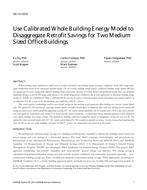Description
Whole-building energy simulation is widely used to evaluate alternative new building design strategies, compliance checks with energy codes, apply certifications based on the conceptual/detailed design. For an existing building retrofit project, calibrated building energy models (BEMs) are usually used to assess savings from different building energy conservation measures (ECMs), discover the optimized retrofit plan and operation algorithms during a Level II/III energy audit process or the retrofit design phase. Defined as one of three approaches to determine building energy savings in ASHRAE Guideline14-2002, a calibrated BEM can also be used to accurately analyze system interactions and evaluate impacts of an individual ECM as part of the measurement and verification (M&V) process.
This article reports a methodology used to assess retrofit savings for two medium-sized commercial office buildings in a mixed- humid climate zone. The applied ECMs consisted of: converting manual switch- controlled interior lights to dimmable lights with day-lighting harvest control and occupancy sensor based control capability; upgrading existing HVAC system control algorithms- for air handler unit (AHU) duct static pressure reset and supply air temperature reset control; CO2 based demand control ventilation. A conventional inverse modeling approach is first adopted to assess whole building level energy savings. This followed by building calibrated EnergyPlus models to disaggregate savings for each ECM. The approaches show consistent results with HVAC system control related ECMs account for majority of savings. Lessons learned from implementing these ECMs in two case study buildings and from the M&V process are summarized and discussed in this paper.
Citation: ASHRAE Papers CD: 2014 ASHRAE Annual Conference, Seattle, WA
Product Details
- Published:
- 2014
- Number of Pages:
- 8
- File Size:
- 1 file , 2.5 MB
- Product Code(s):
- D-SE-14-C039




